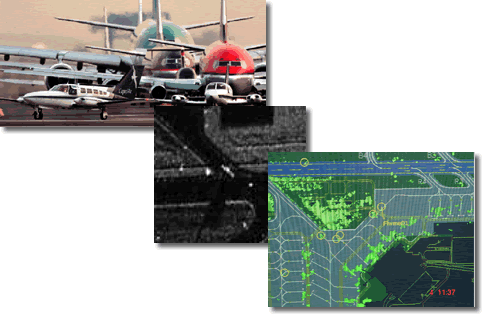Analysis
and Evaluation of different Surface Tracking Algorithms for Advanced
Surface Movement Guidance and Control System (A-SMGCS)
Mauro Leonardi
Abstract
In
the work, after a short description of the Advanced Surface Movement
Guidance and Control System (A-SMGCS) and a remind of the classical
algorithms for target tracking, some original approaches for tracking
in SMGCS are proposed.
In particular, our attention was focused on Adaptive Filtering and on
Multiple Model Approach (IMM – Interacting Multiple Models). We
propose the use of topographic information of the aerodrome to improve
the performance of the Tracking System introducing the concept of Topographic
Alpha Beta Filter, Topographic Kalman Filter and Topographic IMM.
A large number of trials was done both with simulated data and with
real data.

The
performance evaluation of the proposed algorithms is not so simple due
to the large number of parameters that must be fixed and due to the
number of parameters to be optimised.
Moreover, even if at the moment of writing this document it could not
be possible to test topographic algorithms on real data due to the lack
of Frankfurt Airport detailed maps asked to the relevant authorities,
we can simple extrapolate the results obtained for the adaptive filtering.
In fact due to the logics used in Topographic Algorithms and also as
confirmed by simulated situation, the topographic information can only
improve the performance of the filter.
After the analysis of the results we can assert that a good trade-off for A-SMGCS can be the Topographic Kalman Filter that has the following advantages with respect to the other algorithms:
- Very high performance in term of accuracy error;
- Very good performance in term of Gating Probability and Wrong Track Termination;
- Low computational load as compared to the IMM solution;
- Capability to change the gating window’s size dynamically;
- Capability to carry out the estimation of the precision of the prediction (and so the gating windows size).
In the last
part of the work the adaptive filters (Alpha Beta and Kalman) have been
also implemented in C++ and integrated in the A-SMGCS software to verify
the real time capability and to verify the quality of the display of tracks
on the Controller Working Position.
It would be also reminded that various campaigns of study were done in
various Italian and foreign airports to:
- Interview the controllers
- Analyse the installed Systems
- Collect Raw Data
At the moment more than 80 Gb of Venice airports raw radar video were collected and are under test to increase the confidence of our choice.